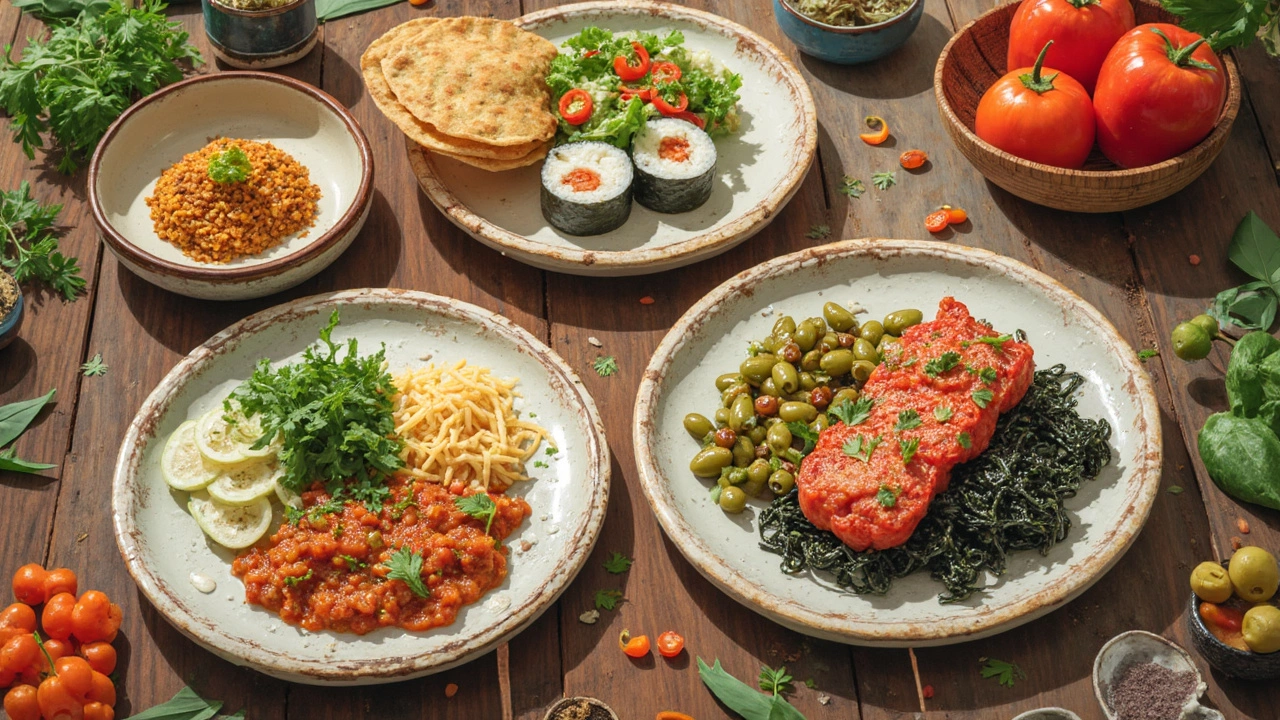Ever wonder why some folks seem to live longer and dodge chronic illness just by eating what their grandparents ate? When it comes to national diets, not all plates are created equal. Some countries have food traditions so strong and balanced, they grab the attention of doctors and wellness experts worldwide. But digging into what makes a country's diet 'healthy' goes way beyond just counting calories or eating a rainbow of veggies.
People actually travel for this stuff—choosing locations for medical treatments based on what they’ll be eating as they recover. Makes sense, right? Nobody wants to heal up eating mystery meat or sugary snacks. So, which nationality really takes the top spot for eating healthy, and why should you care if you're hopping a plane for health reasons? We’ll break down what these cuisines get right, and how you can steal a few tricks no matter where you are in the world.
- How National Diets Stack Up
- Secrets from the Mediterranean Table
- Asian Eating Habits That Set the Bar
- Scandinavian Simplicity: What Works
- Travel Tips for Healthy Eating
How National Diets Stack Up
If you're reading up on healthy eating across borders, there are some real standouts you can't ignore. The Mediterranean, Japanese, and Nordic diets come up again and again when doctors talk about lower heart disease, longer lifespans, and fewer cases of obesity. But it's not just hype—there's hard data to back this up.
Let’s look at the numbers side-by-side. Here’s how people from different spots eat—and what it means for their health:
| Country/Region | Life Expectancy (years) | Obesity Rate (%) | Main Diet Features |
|---|---|---|---|
| Japan | 84.7 | 4.5 | Seafood, rice, veggies, low sugar |
| Italy (Mediterranean) | 83.1 | 10.7 | Olive oil, tomatoes, whole grains, fish |
| Norway (Nordic) | 83.5 | 23.1 | Fish, root veggies, berries, whole grains |
| United States | 76.4 | 36.2 | Red meat, processed food, high sugar |
Check out Japan’s numbers—life expectancy is the highest, and obesity rates are super low. Go over to Italy and Norway, and you see a similar pattern. The folks eating traditional foods like oily fish, leafy greens, beans, and very little junk live longer and dodge a bunch of illnesses.
What about some common threads? Nearly every healthy diet that scientists rave about has three things:
- Lots of natural, unprocessed foods (think veggies, beans, grains, and nuts)
- More fish than red meat
- Less added sugar and barely any soda or energy drinks
But it’s not all rainbows. When folks in these countries ditch their native eating styles for fast food, their health stats start to slide. The bottom line: Local food habits aren’t just tradition—they’re a model for anyone who wants to eat smarter, whether you’re heading there for medical care or just copying their best moves at home.
Secrets from the Mediterranean Table
If you ask most doctors or nutrition nerds about eating for a long and healthy life, they’ll mention the Mediterranean way of eating without skipping a beat. This isn’t just hype—back in the 1950s, scientists noticed that people living in places like Greece, southern Italy, and parts of Spain had way less heart disease, even though they didn’t have fancy gyms or diet shakes. Since then, study after study backs up that folks who eat like the Mediterranean region do often end up with lower risks of diabetes, stroke, and even cancer.
Here’s what sets the Mediterranean diet apart: it’s loaded with fresh produce, whole grains, beans, nuts, olive oil, and more fish than red meat. People in this region know how to keep portions in check and stay away from processed stuff. If you’re worried that eating healthy means being hungry or bored, this is where things get interesting—the meals are famous for their taste, not just their nutrition labels.
- Olive oil isn’t just for salad dressing; it’s used every day as the main fat. It’s loaded with heart-friendly compounds that cut bad cholesterol.
- Fruits and vegetables land on almost every plate, sometimes in two or three meals a day. There’s no skimping or treating veggies like a sad side dish.
- Instead of red meat, folks swap in oily fish like sardines or salmon twice a week for all those omega-3 fats your body loves.
- A handful of nuts or seeds between meals is totally normal—no bags of greasy chips or sugary bars in sight.
- Wine makes an appearance too, mostly at dinner, but always in moderation and paired with food.
It’s not just about what’s on the plate, either. Family meals, long lunches, and a chill pace take the stress out of eating. That’s a big deal—there’s actual medical evidence that mealtime together can keep your head and heart healthier. So if you’re in the Mediterranean for healthy diet inspiration, swipe their tricks: eat more plants, drizzle with olive oil, let food bring people together, and skip the stress and processed junk. That’s the real magic behind this global wellness superstar.

Asian Eating Habits That Set the Bar
If you look at countries like Japan, South Korea, and Singapore, you’ll see people living longer, healthier lives—and their food is a huge reason why. Take Japan, for example. It’s got one of the highest life expectancies in the world. The secret isn’t some rare superfood; it’s regular meals packed with fish, rice, seaweed, vegetables, and some tofu.
The Japanese way of eating, often called “washoku,” is all about balance and small portions, with lots of flavors but not too much fat, salt, or sugar. Okinawa even has its own spin—folks there are famous for making it to 100 and beyond, usually with a diet that’s veggie-heavy, relies on sweet potatoes instead of white rice, and uses very little processed food.
It’s not just Japan. South Korea dishes out loads of seasonal vegetables, fermented foods like kimchi (great for gut health), and lean proteins like fish and tofu. Meals usually come with a bunch of small, different dishes that help you eat more variety without going heavy on processed stuff.
“Fermented ingredients, such as kimchi, are a daily staple and help keep Koreans’ guts healthy,” says dietitian SungHee Lee, quoted in Healthline.
Let’s get a bit factual. Look at the numbers from the World Health Organization and research studies:
| Country | Daily Veg/Fruit Servings (avg) | Obesity Rate (%) | Life Expectancy (years) |
|---|---|---|---|
| Japan | 7.5 | 4.3 | 83.7 |
| South Korea | 7 | 5.5 | 83.4 |
| USA | 3.8 | 36.2 | 76.4 |
These numbers aren’t just bragging rights—they’re proof these healthy diet habits make a real difference.
- More fish, less red meat: Omega-3s from seafood are proven to help heart health.
- Lots of veggies: Not just the usual salad stuff, but things like radishes, seaweed, and bitter greens.
- Almost every meal has fermented food: Think miso soup, pickled vegetables, or natto (fermented soybeans).
- Less added sugar: Asian desserts are often fruit-based, not calorie bombs.
- Eating as a group: Shared plates slow you down and make it harder to overeat.
Trying to bring these habits home? Swap one meat meal a week for fish, add fermented veggies to your lunch, and try smaller plates. Simple moves, but honestly—they add up.
Scandinavian Simplicity: What Works
If you’ve ever wondered why people in Sweden, Norway, and Denmark seem so healthy, a lot of it comes down to how plain and simple they keep things on their plates. The Nordic diet is proof that you don’t need fancy ingredients to eat well—and it’s not just a trend. Studies keep showing that the Scandinavian way of eating is linked to lower heart disease, steady blood sugar, and even longer lifespan. The World Health Organization actually pointed out that the traditional Nordic diet cuts your risk of chronic disease by about 20% compared to the typical Western diet.
So what’s actually on the menu? Think plenty of whole grains like rye and barley, fatty fish (salmon, mackerel, and herring are staples), root veggies, berries, and dairy from cows that actually roam around. It’s not big on red meat or sugary drinks. The focus is on seasonal, fresh, and local food—stuff you’ll find at the market rather than in packages.
- Whole grains: Dark breads, porridges, and crispbreads are more common than white bread.
- Fatty fish: Lots of fish oil, lots of omega-3, way less processed meat than most other European countries.
- Veggie overload: Potatoes, carrots, cabbage, and peas make up a chunk of most meals.
- Berries: Blueberries, lingonberries, and cloudberries get thrown into cereals or eaten on their own.
- Healthy fats: Rather than sticking with butter, you’ll see lots of canola (rapeseed) oil, which is good for your heart.
Maybe you’ve heard of "friluftsliv"—their love of being outdoors. That attitude spills over into the kitchen, too. People walk, cycle, and spend more time outside, but they also eat with the seasons and keep things natural. You're unlikely to see processed snacks or sugar-loaded drinks in a classic Scandinavian home.
| Diet Feature | Nordic Countries | Western Diet |
|---|---|---|
| Fish Servings/Week | 3-4 | 1-2 |
| Whole Grain Intake | High | Low |
| Processed Food | Minimal | High |
| Fruit & Veg Servings/Day | 6-8 | 3-4 |
| Added Sugar | Low | High |
You don’t need a Nordic passport to eat this way. Even swapping white bread for rye, or adding a couple servings of salmon a week, can help your healthy diet get closer to what they’re doing up north. Doctors in Sweden have even started prescribing the "Nordic diet" for patients with diabetes and cholesterol problems—with real results.

Travel Tips for Healthy Eating
Traveling to another country for medical reasons—or just to try a healthy lifestyle—can mess with your usual eating habits. Local food might taste awesome, but it can be salty, full of oil, or nothing like what you’re used to. Here’s how you can dodge junk and make sure you’re fueling up the right way, no matter where you land.
- Plan ahead: Look up local dishes and their ingredients before your trip. Most Mediterranean and Asian countries use fresh veggies, fish, beans, and whole grains. In Japan, for example, you’re much more likely to find grilled fish than greasy burgers. Italy? Loads of veggies, olive oil, and lean protein (and sure, the pasta too, but in small portions).
- Stick to local markets: Supermarkets and farmers' markets are a goldmine for good food. Fresh fruits, nuts, and yogurt are quick and usually safer than street snacks if you have a sensitive stomach.
- Go easy on sauces and dressings: Across cultures, sauces can hide a ton of sugar and salt. Ask for them on the side. Even traditional dishes, like Thai curries or Greek salads, can surprise you this way.
- Control your portions: Restaurants sometimes serve double what you actually need, especially in touristy areas. Try ordering an appetizer as a main or splitting your meal. Japan has it down with smaller servings, while the Mediterranean diet is famous for lots of tiny side dishes.
- Stay hydrated: Sounds obvious but, travelers often forget. Choose water over soda or sweetened drinks—especially in warmer climates.
Check out this mini-guide for choosing typical foods in popular medical tourism destinations:
| Country | Go-to Healthy Dish | What to Watch Out For |
|---|---|---|
| Japan | Grilled fish with steamed rice and miso soup | Deep-fried tempura, excess soy sauce |
| Italy | Minestrone soup, grilled vegetables, seafood | Creamy sauces, excessive cheese and bread |
| Thailand | Som tam (papaya salad), tom yum soup | Sugary iced teas, coconut milk-heavy curries |
| Greece | Greek salad, grilled octopus, lentil soup | Lots of bread, rich pastries like baklava |
| Sweden | Rye bread with smoked salmon, root veggies | Pickled foods high in salt, creamy sauces |
If you’re serious about sticking to a healthy diet on your trip, use these local tricks: Choose grilled stuff over fried, pile on the veggies, and make water your drink of choice. These moves work almost everywhere, and your body will thank you for it—especially when you’re focusing on your health away from home.

 Herbal Supplements: What Are the 3 Main Supplements You Should Know?
Herbal Supplements: What Are the 3 Main Supplements You Should Know?
 Can You Avoid Knee Replacement if You Are Bone-on-Bone?
Can You Avoid Knee Replacement if You Are Bone-on-Bone?
 What Is the Most Common Orthopedic Emergency? A Deep Dive into Fractures
What Is the Most Common Orthopedic Emergency? A Deep Dive into Fractures
 Understanding Cancer: The Types with the Lowest Survival Rates
Understanding Cancer: The Types with the Lowest Survival Rates
 Can You Get a Prescription Without Seeing a Doctor?
Can You Get a Prescription Without Seeing a Doctor?